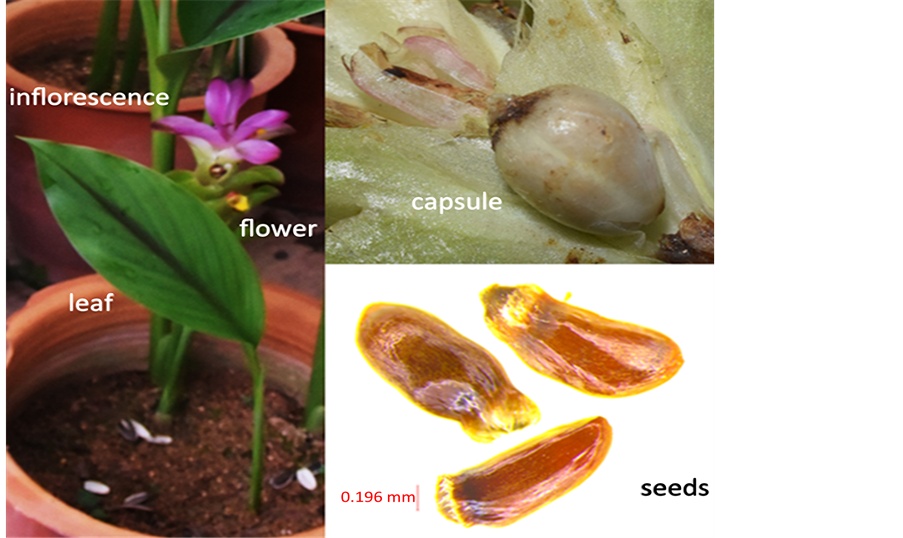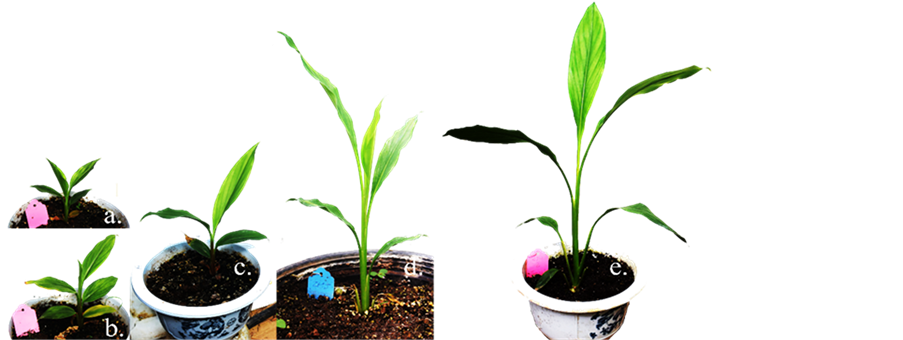1. 引言
姜黄,属于姜科(Zingiberaceae)姜黄属(Curcuma L.)多年生草本植物。在中国传统中药中,已报道的温郁金(Curcuma wenyujin)、川郁金(Curcuma sichuanensis)和桂莪术(Curcuma kuangsiensis)等也都属于姜黄属植物。
姜黄具有重大医学价值和商业开发价值。在国际上,印度姜黄(Curcuma longa L.)是典型的食药两用作物。印度是世界上最大的姜黄生产者和消费者,2012~2013年年度姜黄种植面积达194,330公顷,产量达996,690吨。作为与印度饮食密切联系的姜黄色素,印度的生产量占国际食用姜黄色素进出总量的80%。在印度阿育吠陀医学中记载,姜黄在印度的使用至少可追溯到4000年前。最早被栽培制作染料,后作为香料调味品和美容护肤品。在当时姜黄是印度非常重要的香料,并赋予宗教意义。姜黄能促进血液循环使身体暖和,并能给予虚弱的人能量补气,传统上使用蒸煮的姜黄汁液热敷活血,有益于瘀伤、扭伤,净化血液,消除关节肿胀、指甲真菌、疔疮、蚊虫叮咬等,并能减轻食物中毒。姜黄素,是一类令人难以置信的化学成分,是一种抗炎、抗氧化剂,被用来治疗痢疾,避免肝脏受酒精或药物的残害,降低胆固醇和防止血液凝集而引发心脏病和中风。现代医药研究证明,姜黄中还含有多种药用活性成分。从姜黄提取的姜黄精油和姜黄素,具有抗氧化(Antioxidant activity)、抗炎(Anti-inflammatory activity)、抗癌(Anti-tumour activity)、抗菌(Antimicrobial activity)、抗蛇毒(Antivenom activity)、抗艾滋病毒(Anti-HIV)等功效 [1] 。在中国药典(2005版)中记载的姜黄产品中莪术油(注射液)作为抗病毒药、抗癌药,莪术(姜黄根茎)片作为中药治疗癥瘕痞块、瘀血经闭、食积胀痛和早期宫颈癌,郁金(姜黄块根)片作为中药治疗经闭痛经,胸腹胀痛、刺痛,热病神昏,癫痫发狂,黄疸尿赤 [2] 。近期国际上还开辟了姜黄保肝护肝(hepatopropective)和治疗心血管疾病及胃肠道疾病的新用途。由于目前生产用品种都是克隆繁殖的,因此姜黄产品质量和药用效能降低的情况在逐渐凸现出来,成为姜黄产业化发展的瓶颈问题。
高精油含量和高块根产量是目前姜黄育种的两大目标。精油(essential oil)是姜黄医药开发最具潜力的组份。块根(tuberous roots)中国药典上称之为“郁金”,是中药开发主要的器官;根茎(rhizomes)被称为“莪术”,是开发姜黄素的主要原材料。围绕这两大目标,国内外都已做了许多有成效的种质资源收集和育种工作,如泰国发现姜黄三倍体 [3] 。但由于姜黄植物罕见结籽,目前商业化种植中采用的姜黄品种都是通过发芽根茎和叶鞘 [4] 、腋芽、假茎、幼叶、茎尖、幼穗等外植体组织培养 [4] - [11] 出来的。采用营养繁殖的方法,我国在浙江 [12] 、四川 [13] 和广西 [14] 也培育几个姜黄优良新品种。本研究首次采用杂交遗传重组的方法,创制出了新的姜黄突变体,这将为高精油和高产姜黄品种的培育提供优良种质资源。
2. 材料和方法
2.1. 姜黄种子来源
2015年5月,在西双版纳植物园姜黄种质资源保存区内,首次发现姜黄结出的蒴果,见图1。果实晾干后从姜黄蒴果中剥离得饱满种子35粒。
2.2. 姜黄种子处理
从姜黄蒴果中剥离的种子经过了20天的后熟期。贮藏条件为玻璃干燥器,姜黄蒴果放在干燥器上层带孔瓷板上,瓷板下层放硅胶粒吸湿水汽。5月25日被置于烧杯中用自来水。浸泡7天。种子吸胀后,被分别点播在盛有细沙和腐质土的两个方盆内,然后用塑料薄膜覆盖保湿,每隔2天浇水1次,浇水之前检查种子萌发的情况。用塑料膜覆盖盆口后,小方盆盆内相对湿度75%~80%,塑料膜透光系数为80%~85%。
2.3. 形态特征及其变异水平度量
株型变化:定期观察记录每个植株的茎秆高度、颜色,叶片的颜色及数目。植株高度和粗度,采用钢尺测量;颜色记录采用拍照对比方法。
形态特征:从幼苗出土开始,每隔3天,对出土幼苗拍照1次,每周对出土幼苗株高、叶片大小测量1次。发现变异即作出标记。用游标卡尺测量叶长(leaf length)、叶宽(leaf width)、叶柄长(petiole length)。
微形态特征:包括叶表面角质层细胞形状、大小和排列方式,气孔的分布、密度和大小,毛状体的数量、特征等,均采集新鲜叶片,在莱卡体式显微镜下现场观察、拍照,并利用显微计数、测量工具,记录各项相关性状指标数据。
植株地下部分生物学观察:包括根茎、块根和须根等,每个月挖出观察1次,主要观察其发生的先后次序,不同芽体形态、大小和数目。
2.4. 数据统计
利用SPSS 13.0统计分析软件进行差异显著性检验、均值和标准差计算,对姜黄突变植株形态指标的差异进行t-检验,推断每种处理对所观测性状的影响。
3. 结果与讨论
3.1. 姜黄自交后代中种子的萌发和幼苗生长
幼苗出土最初显露的是芽鞘,顶端呈钝圆形。6~7天后芽鞘逐渐伸长、变尖,从中心抽出第一片幼叶,初呈尖的斜切口形,遂后逐渐出现偏斜的漏斗形、铲形和弯槽形。与此同时,地下部分种子根原基不断膨大,并产生许多的牙状体,最先分化出种子根,由一根、三根、五根至更多,种子根逐渐增加。种子根伸长生长到一定程度,便开始结瘤,最终形成块根。除此之外,在种子根周围附近,也分化出许多细根。这些细根可进行多级分枝,微管束中纤维坚硬,其结构和功能类似竹根,主司营养吸收的功能(见图2)。
姜黄自交后代实生苗生长量调查见表1。由表1可见,自幼苗出土开始,在前期(30天)植株生长十分

Figure 1. Turmeric capsule and seeds of self-fertilization
图1. 姜黄自交结出的蒴果及种子

Figure 2. Seed germination and seedling growth of the self-progenies of turmeric. (1) Shooting growing roots from seed; (2) The seedling in different stages of growing
图2. 姜黄自交后代种子的萌发与幼苗生长。(1) 种子萌发和幼根萌生和伸长生长;(2) 处于不同发育阶段的幼苗

Table 1. The growth of seedling of the turmeric inbred progenies
表1. 姜黄自交后代实生苗的生长量
缓慢,植株高度月平均生长量仅0.5 cm;进入第2个月,月均生长量增至4.0 cm,但只有克隆苗的1/2;第3个月、4个月,月均生长量分别增至10.0 cm和17.5 cm,但与克隆苗相比,实生苗的生长量(包括高度和冠幅)仅是克隆苗的1/2。
3.2. 姜黄自交后代中的表型变异
姜黄自交后代中的株型变异见图3。观察结果(图3)表明,姜黄自交后代中出现了明显的株型变异。根据叶片形状和颜色的变化,可分为5个类型,即箭形叶(图3a)、船形叶(图3b)、竹叶形(图3c)、柳叶形(图3d)和桨形叶(图3e)。
根据茎秆(下部)颜色的变化,可将姜黄自交后代分为两个类型(见图4-(1))。一是紫秆,包括前述船叶

Figure 3. Variation in plant types of the self-progenies of turmeric
图3. 姜黄自交后代的植株类型的变化

Figure 4. Variation in leaf-shaped types and Micro morphology for the leaf surfaces of the self-progenies of turmeric. a. arrow-shaped leaf; b. boat-shaped leaf; c. bamboo-leafed; d. willow-shaped leaf; e. oar-shaped leaf; ck. clonal seedling. (1) leaf-shaped variation; (2) changes in leaf of venation; (3) changes in leaf of cuticle cell and stomata density; (4) changes in leaf of somatic morphology
图4. 姜黄自交后代的叶型和叶表面微形态特征的变化。a. 箭叶型;b. 船叶型;c. 竹叶型;d. 柳叶型;e. 船桨叶型;ck. 克隆苗叶片类型。(1) 叶型变化:(2) 叶脉脉序的变化;(3) 角质层细胞和气孔密度的变化;(4) 气孔形态的变化
形(图4-(1b))、竹叶形(图4-(1c));二是绿秆,包括箭叶形(图4-(1a))、柳叶形(图4-(1d))和桨叶形(图4-(1e))。各类型的表型特征如下:
箭叶型的特征:植株矮小,茎秆绿色,叶表面灰绿色、毛比较多(48),叶片致密,叶片上半部呈箭头状,叶柄较短。叶片主脉粗,脉岛区细胞梯形、珠形相间排列;角质层细胞排列错位,有6.5行。
船叶型(椭圆形)的特征:植株高度中等,茎秆紫红色,叶面呈黄绿色,平行脉间距较大,脉相清晰。主脉较粗,多边(六边)形细胞(14)头尾相接而成(白色)。主脉两侧团状细胞有序排列(7),多数细胞长宽等距,少数长块状。
竹叶型(披针形)的特征:植株高度中上,茎秆紫红色。叶片形似竹叶、较长、致密,表面多毛(28)。主脉粗,两侧有三角形花边细胞14;有团状细胞族(12)、三角瘪细胞凹陷。
柳叶型的特征:植株稍显细长、高挑,似玉米植株。茎秆黑绿色,叶片窄而长、似扭曲的柳叶。叶表面黑绿色、毛较多(36),主脉较细,叶脉细胞奶头状(10)头尾相接而成(白色)。主脉两侧各有两列奶头状细胞,其中每列伴有少量圆点状细胞(4)。有碎片状角质层凹陷区域,中间穿插鳞片状细胞。
桨叶型的特征:植株高大,茎秆绿色,叶片长而宽、长椭圆形(或船型)。叶表面呈黑绿色、毛比较少(9)。叶片主脉粗,类似人类脊椎,由梯状细胞(12)排列而成;有片状细胞族凹陷、周边方条形细胞相伴。
3.3. 姜黄自交后代中不同表型变异的比较
姜黄自交后代不同基因型叶表面性状的测量见表2和图5。在株型大小上,箭叶型(JY)植株最小,相应的叶片长度(9.1 cm)亦最小,叶片宽度(2.3 cm)与柳叶型的相似,较船叶型和竹叶型的叶短和宽。柳叶型的叶片最窄(1.9 cm),叶长(36.0 cm)仅次于船桨叶型的叶长(45.0 cm),远长于其余三个类型。船桨叶型株高最大,叶片比较长(21.2 cm)和比较宽(4.0 cm)。
在叶片微观形态上,观察(图4-2)发现不同的表型(基因型)叶脉主脉均是9根,呈弧线排列。但主脉之间的距离,则因表型(基因型)类型的不同,疏密各有不同。箭叶形和柳叶形两种类型的主脉间距最短;船叶形和竹叶形的主脉间距相似,但宽于前两种类型,而较船桨叶形的要窄。在叶脉的长度上,则与叶片长度相适应,叶片愈长叶脉也愈长。
叶脉主脉之间“脉岛”细胞的形状、大小和排列方式,反映了姜黄自交后代中的类型分化。观察发现,柳叶是姜黄自交后代中出现的一个极端类型(见图4-2),叶窄而长,表面绒毛多(36)、质地比较致密、叶脉脉象模糊,气孔宽大但密度小(48),角质层细胞呈鱼鳞片状,叶脉纤细并在结构上由奶头状细胞首尾衔接而成。
船桨叶形是一个叶片宽而长的类型,叶脉较为清晰,绒毛多(48),气孔密度大(68),角质层细胞长条形和团形(多边形)掺拌,靠近叶脉处为条形,脉岛中央多为团形,气孔大小中等,但气孔上下三角形构造明显。
箭叶形,是叶形最小的类型,叶片质地与竹叶形相似,表面多毛(48),气孔小、密度大(78),叶脉间脉岛上的角质层细胞以正多边形为多,但排列不规律,呈现明显的脉岛细胞集团。
竹叶形和船叶形,为中间类型,二者之区别叶表面绒毛的数量和气孔的密度。二者的绒毛数分别28和16,气孔数分别为58和90。再有就是竹叶形叶片密实,角质层细胞构成类似于箭叶形;而船叶形的粗燥、角质层细胞构成以条形为主,类似于船桨叶形。
3.4. 姜黄自交后代中不同遗传型结瘤(块根)特性
根据观察(见图6)发现,姜黄自交后代中不同遗传型(基因型),除上述地上部表型上的差异外,在地下部根系的分布、结瘤的大小和形状上也显著不同。由图6可见,箭叶型(图6a)根须和结瘤数目均比较

Table 2. Determination of phenotypic characters of the turmeric inbred progenies
表2. 姜黄自交后代不同基因型叶表面性状的测定

Figure 5. The trends in the characteristic character of different phenotypic plants with the number of leaves of the turmeric inbred progenies. LL: leaf length, LP: leaf petiole, LW: leaf width. JY: arrow-shaped leaf; LY: willow-shaped leaf; ZY: bamboo-leafed; CY: boat-shaped leaf; CJY: oar-shaped leaf; CL: clonal seedling; EZ: Zodoary (Curcuma zedoaria Roscoe); JH: Turmeric (Curcuma longa L.)
图5. 不同表型叶片数递增与叶片特征形状的变化趋势. LL-叶长, LP-叶柄, LW-叶宽. JY-箭叶形;LY-柳叶形;ZY-竹叶形;CY-船叶形;CJY-船桨叶形;CL-克隆苗;EZ-莪术;JH-姜黄

Figure 6. The characteristic character of different genotypic plants of the turmeric inbred progenies
图6. 不同基因型植株的结瘤特性
少;船叶型(图6b)结瘤大小均匀,呈长赘形和尾突较短;竹叶型(图6c)结瘤有圆形的,也有哑铃型的,前者(圆瘤)尾突很短,后者尾突较长;柳叶型(图6d)结瘤短小,尾突似长长的锥尖;桨叶型(图6e)结瘤成扁圆形、个数多;克隆苗(ck)结瘤以扁圆形较多,且在须根上也结出小小的根瘤,另有新长出的根茎。
4. 结论
遗传重组仍是姜黄新种质创制的有效方法。长期以来,无论国内还是国外,姜黄新品种 [13] [14] 几乎都是通过营养外植体培育而成的。营养体培植的新品种,优势在于群体内不同个体之间都是共同的基因型,劣势在于这类品种品质和产量衰退得快,在生产上要不断地更新复壮 [15] [16] [17] ,以维持优质高产。本研究,利用遗传重组创制了姜黄新的基因型,并在结瘤(郁金)产量上有一定优势,对姜黄育种有重要意义。
与现有姜黄品种比较,本研究创制的姜黄新的基因型,除了表型特异性之外,最突出的是块根(结瘤)比较发达,而根茎(莪术)相对较弱。针对现有品种根茎比较发达而块根较少的问题,这些新类型的出现对改良现存姜黄品种已有重要的现实意义。
通过初步测定,本研究创制的新类型根茎和叶的精油产量分别为5.8%和1.8%,根茎中姜黄素达2.8%,远超过现有品种(1.5%)且在精油主要成分上有显著差异(结果将在另文报道),因此在新药和新农药开发上有良好的前景。
基金项目
国家自然科学基金(No. 31270704),“十一·五”国家科技支撑项目(No. 2007BAD32B0202)。农业部科技发展中心“姜黄品种指南研制”专项。